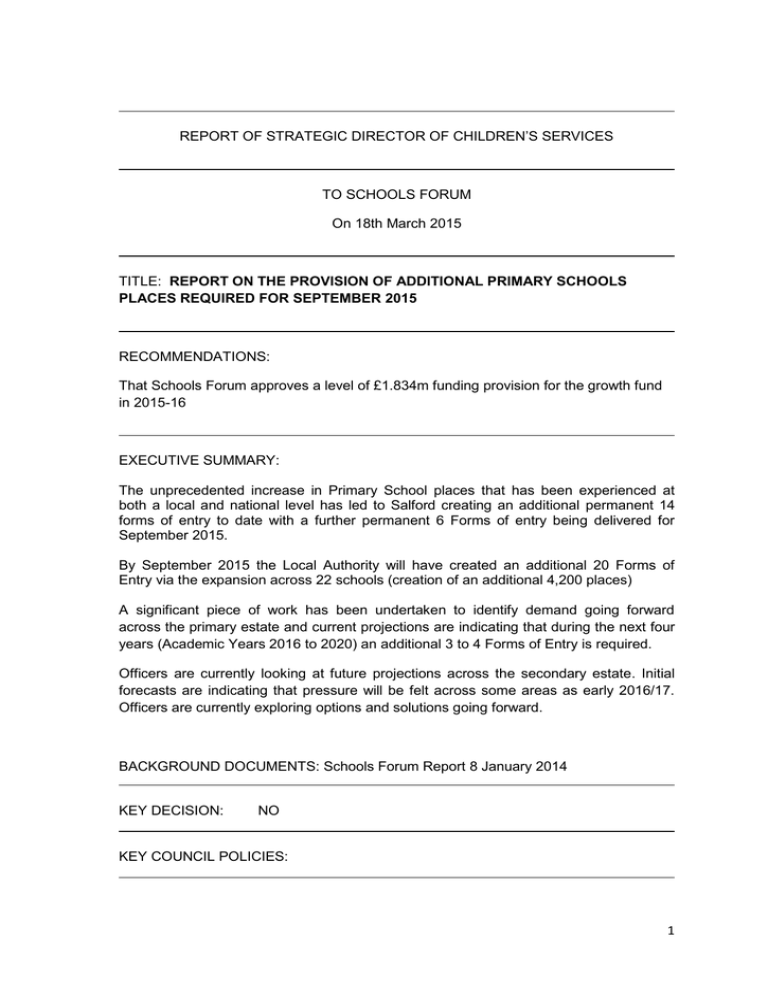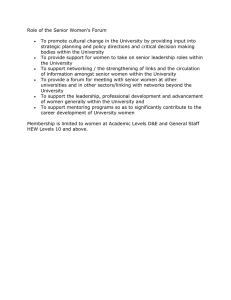REPORT OF STRATEGIC DIRECTOR OF CHILDREN’S SERVICES TO SCHOOLS FORUM
advertisement

REPORT OF STRATEGIC DIRECTOR OF CHILDREN’S SERVICES TO SCHOOLS FORUM On 18th March 2015 TITLE: REPORT ON THE PROVISION OF ADDITIONAL PRIMARY SCHOOLS PLACES REQUIRED FOR SEPTEMBER 2015 RECOMMENDATIONS: That Schools Forum approves a level of £1.834m funding provision for the growth fund in 2015-16 EXECUTIVE SUMMARY: The unprecedented increase in Primary School places that has been experienced at both a local and national level has led to Salford creating an additional permanent 14 forms of entry to date with a further permanent 6 Forms of entry being delivered for September 2015. By September 2015 the Local Authority will have created an additional 20 Forms of Entry via the expansion across 22 schools (creation of an additional 4,200 places) A significant piece of work has been undertaken to identify demand going forward across the primary estate and current projections are indicating that during the next four years (Academic Years 2016 to 2020) an additional 3 to 4 Forms of Entry is required. Officers are currently looking at future projections across the secondary estate. Initial forecasts are indicating that pressure will be felt across some areas as early 2016/17. Officers are currently exploring options and solutions going forward. BACKGROUND DOCUMENTS: Schools Forum Report 8 January 2014 KEY DECISION: NO KEY COUNCIL POLICIES: 1 EQUALITY IMPACT ASSESSMENT AND IMPLICATIONS: Without this additional provision, inequality will be created across the city. A failure to provide places will have an adverse impact on the pupils’ families and communities who will be directly affected by lack of suitably located places. ASSESSMENT OF RISK: High risk of the Local Authority not being in a position to fulfil statutory responsibility to provide school places for eligible applicants within Salford. _____________________________________________________________________ SOURCE OF FUNDING: Basic Need Fund for identified Capital works and Dedicated Schools Grant for Revenue LEGAL IMPLICATIONS Supplied by: N/A FINANCIAL IMPLICATIONS Supplied by: Chris Hesketh – Strategic Finance Manager and Debbie Fulton – Finance Officer Funding has been set aside in line with previous year’s requirement for growth funding. The approved schools growth budget for 2014-15 is £1.92m. The actual expenditure is £2.08m which is an overspend of 0.16m. For 2015-16, schools forum is asked to approve a budget of £1.834m, see section 4. Without the funding schools would not be able to financially support the predicted increase in pupil numbers. _________________________________________________________________ ___ PROCUREMENT IMPLICATIONS Supplied by: NA OTHER DIRECTORATES CONSULTED: CSSD CONTACT OFFICER: Paula Flynn TEL NO: 778 0447 WARDS TO WHICH REPORT RELATES: ALL 2 1. Background The unprecedented increase in Primary School places has been experienced at both a local and national level. Initially additional places were created through establishing ‘bulge’ provision, predominantly in existing unused space in schools. This addition has successfully created sufficient temporary ‘bulge class’ places to meet demand and provide much needed surplus across all areas of the city. Running parallel to this there has been a large amount of work involving extensive reworking and refreshing of methods and systems, including the creation of 12 new school planning areas. Analysis in spring 2013 confirmed the effectiveness of the predictive methods, reliability of the implementation process and general successful management of the programme going forward. 2. Creation of Permanent Places Projections going forward high-lighted that there would be a continued demand for places and as such plans were put in place for permanent expansion of existing schools. This has resulted in permanent increase in PAN across 22 schools, equating to an additional 20 Forms of Entry (additional 4,200 places). To date, there are only two Primary Schools (St John’s CE located in area 8 and the proposed expansion of St Luke’s CE, located in adjacent planning area 9) that have required the use of additional vacant city council owned land (Former Oakwood High School site and former All Hallows RC High site). All capital costs relating to the increases (bulge classes and permanent expansions) have been met via the Local Authorities Basic Need funding. To date a total of £21m has been spent from Basic Need with a further £20.5 million being available for delivery of the 2015/16 and 2016/17 schemes. 3. Future Primary Demand A significant piece of work has been undertaken to identify demand going forward. In order to meet demand for September 2015 a further 6 permanent Forms of Entry are being created, with a projected further 3 to 4 Forms of Entry being required over the next 4 years (Academic Years 2016 to 2020). The issue now however relates to the long term proposals (post 2015). There are still a number of schools that would allow for further on site expansion and therefore where possible we will continue to undertake permanent uplifts across these sites. That said, we also now have a number of critical areas where we have either exhausted all options or there is very little option for any further on site expansion. Examples of this 3 would be Area 8 and 12. We therefore need to consider other options which will enable the local authority to provide sufficient school places across each of the areas .i.e. use of vacant sites/accommodation in order to expand existing schools. This may also have additional impact on the schools growth budget, especially if the solution is for a split site. We may also need to explore the potential to create more 3 Form Entry schools. It should be noted however that a 3 Form Entry expansion is not a solution for all and that careful consideration would have to be given based on the individual school. This would be measured on more than just demand and physical capacity to ascertain whether this solution is workable for a particular school. Another factor that needs to be taken into consideration relates to the housing developments which are planned in various locations across the City. A significant piece of work on the formulaic calculation of child yield has been carried out and we are now using recent trend data. This is proving fairly accurate at predicting the number of children likely to arrive into Salford but clearly not the age group/Key Stage in which they will require a place. As such the projected forecast as outlined above excludes any proposed housing. We do however work very closely with our colleagues within regeneration and planning and undertake regular reviews on current numbers and demand. In year applications are still high across certain areas of the city and placing families together can be challenging. We are therefore trying to carry between a 5% and 8% surplus across each school planning area. At present, we are still managing to keep allocations within 2 miles of the home address (other than by parental choice). Secondary Forecasts We are currently looking at future demand required across the secondary estate. Initial forecasts are indicating that pressure will be felt across Year 7 areas as early 2016/17 with the need to create additional physical Year 7 places by 2017/18. That said from a citywide view, there will be sufficient capacity across Year 7 until 2018/19 academic year but this would mean children having to travel further away from their own community for schooling. It would also leave the city with very little surplus capacity. Officers are therefore currently exploring options and solutions going forward. As with the primary, the secondary strategy will split in to a short, medium and long term programme, with the short and medium term providing quick fix solutions i.e. bringing into use existing under used accommodation. Schools have also been split into planning areas, however unlike the 12 primary planning areas, secondary are split across 3 main areas covering the north, south and east of the city. Proposed solutions going forward will be shared with Schools Forum once the full piece of work has been approved with Mayoral Working Party. 4 4. Revenue Funding Required for 2015-16 The approved schools growth budget for 2014-15 is £1.92m, including a £0.5m additional allocation made on a one-off basis. Actual expenditure is £2.08m, which is an overspend of 0.16m. Assuming no increase, the growth budget for 2015/16 stands at £1.42m, the same as the base budget for 2014/15. Taking into account the discussion in sections 2 and 3 above, and known and estimated pupil number projections, an estimate of the 2015/16 demand on the growth fund has now been made. This forecast indicates a potential requirement of £1.73m, £0.3m in excess of available funds, as set out below and in the attached spreadsheet appendix. Growth fund, projected expenditure summary 2015/16 £000 Growth & continuous growth funding Estimated possible additional bulge classes (based on previous years) Estimated trigger funding - primary Estimated trigger funding - secondary Total projected estimated growth & trigger funding 1,163 Base budget 2015-16 1,420 Projected shortfall in funds 100 100 370 1,733 -313 The DSG report to schools forum of 7 January noted the possibility of additional calls on the growth fund above the £1.42m budget, although no additional provision was made at the time. The report also outlined the proposed distribution of DSG through the schools funding formula. Schools Forum members will appreciate that the funding arrangements from government to the authority, and from the authority to schools, are complex and, unfortunately, an error was made. It has since been discovered that the proposed allocation leaves £0.414m of DSG undistributed. While unintended, this gives the opportunity of meeting the expected additional pressure on the growth fund from within existing DSG resources. It is therefore proposed that the additional £0.414m is allocated to the growth fund in 2015/16. This would cover the forecast demand with tolerance for a small increase, if required. If pressures on the growth fund are less going forward, then the additional amount allocated in 2015/16 would be returnable to the schools funding distribution from 2016/17. 5 5. Conclusion While the number of additional pupils in Salford is increasing the overall volume is predicted to remain more static over the next five years. Nevertheless, there are pressures on the base budget provision for the growth fund in 2015/16 which can be met, with Schools Forum approval, from an unallocated amount of DSG. 6. Recommendations That Schools Forum approves a level of £1.834m funding provision for the growth fund in 2015-16. 6

